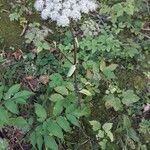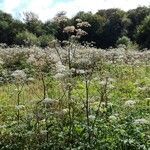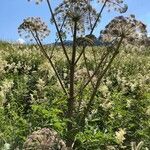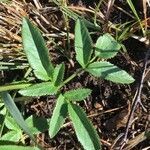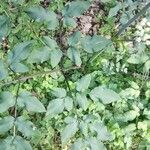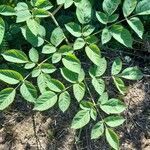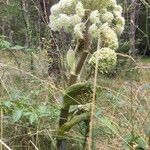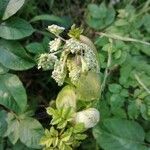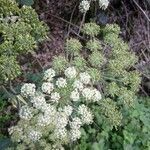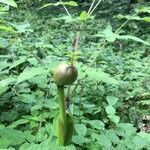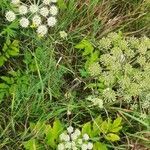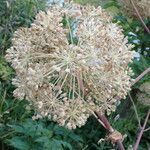Plants perennial, 0.8–2 m. Root conic, thick, slightly aromatic. Stem 1–2.5 cm thick, ribbed, pubescent below umbel. Basal and lower leaves petiolate, petioles long, sheaths ovate to saccate-inflated; blade broadly triangular-ovate, 2–3-pinnate; leaflets sessile, lanceolate to ovate, 2.5–8 × 1–4 cm, base cuneate, margin serrulate, slightly hispidulous along nerves. Umbels 10–20 cm across; bracts absent or 1–2, linear, deciduous; rays 15–30, pubescent; bracteoles many, linear, as long as pedicels. Calyx teeth obsolete. Petals white, ovate to obovate. Fruit broad-ovoid, 5–6 × 3.5–5 mm; dorsal ribs filiform, lateral ribs winged; vittae 1 in each furrow, 2 on commissure. Fl. Jun–Jul, fr. Aug–Sep. n = 11*.
More
A small plant. It grows for 2 years or can keep growing for a few years. It grows 2 m tall and spreads 1 m wide. The underground stem or rhizome is thick. The stems are erect and hollow and branch at the top. They are purple. The leaves are green and divided 3 times and are triangle shaped. They are 60 cm long. There are teeth along the edge. The flowers are white in compound groups at the top of the plant. The fruit are oval and flattened. There are wings along the edge.
Found mainly on base-rich soils in moist fields and hedgerows, open woods, marshes and fens, not usually found on acid soils. Forest margins, damp grasslands, marshy areas, river banks; at elevations from 900-1,100 metres.
More
It is a temperate plant. It does best in moist rich soil. It needs a protected slightly shady position. It cannot tolerate drought. It can tolerate frost.
